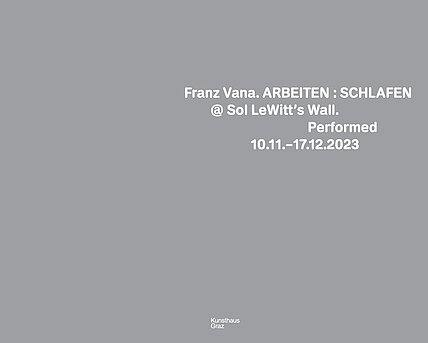In Sol LeWitt's Wall. Performed, the conceptual painter Franz Vana follows performative interventions by Jasmina Cibic, Franz Jochum and Winfried Ritsch. Engaging with the theme Artwork and Work, Vana contrasts LeWitt’s constructed Wall with expressions in painting that can be experienced both in conceptual and physical terms, confronting the monumental wall as compositions of form.
For Sol LeWitt, the idea was not just the starting point but also the most important aspect of his work, while its execution was secondary. His texts Paragraphs & Sentences on Conceptual Art formulated the meaning of the idea for art. Now, in 2023, they also serve as a departure into what is to come. In three sections – Concept: Protocol for Utopia / Artwork and Work / Variation and Dialogue – the work is explored in its various facets as an idea, as a built artwork and as a modular spatial intervention. The Wall becomes a reflection surface for new approaches and altered perceptions.
Franz Vana (*1951) uses language and formal painting discourses for his distanced and surreal image analyses. The serial combination of related vocabularies in word and image becomes a conceptual method of evaluating fixed imaginaries. Humour sometimes serves as a weapon used against himself, irrational ideas are followed in a logical and consistent way, just as Sol LeWitt proposed in his Paragraphs on Conceptual Art back in 1967. Honed over decades, Vana’s consistency in critical and precise painting makes him one of the most interesting outsiders of Austrian art in his generation and an exemplary counterpart to Sol LeWitt’s conceptual artwork of the modular Wall drawn through space.
‘Word pictures’ alternate with ‘Sunday pictures’. While semantic recombinations appear on the one hand, geometric shapes and forms are mixed on the other. This reconfiguration becomes a poetological game and an exploration of irrational patterns and narratives.
‘Vana’s current restless point of view in painting and object art, encompassing many directions, is that of a constantly expanded hierarchy-dissolution of what in 1986 was called “Neo-Post-Conceptualism”. (...) Vana’s language games do not serve any regulated system, even if they are accompanied by concrete colors, chemical elements, Pythagorean number symbolism, advertising slogans, or with the form of advertisements – what always remains is a free flotation with associative chains, with which the artist is meticulously careful not to follow a logic that makes sense.’
Brigitte Borchhardt-Bierbaumer (From the catalogue ARBEITEN : SCHLAFEN, to be presented at the exhibition opening)
‘When an artist uses a multiple modular method
he usually chooses a simple and readily available form.
The form itself is of very limited importance;
it becomes the grammar for the total work.’
Sol LeWitt, Paragraphs on Conceptual Art, Artforum 1967




























